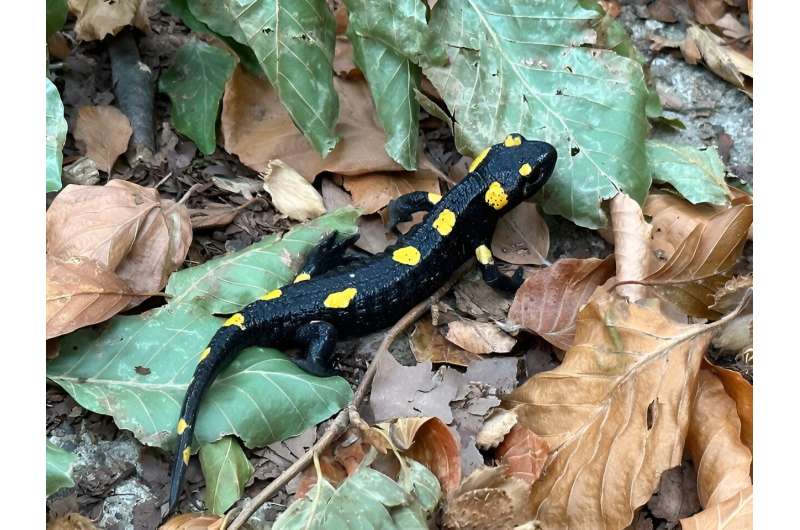This article has been reviewed according to Science X's editorial process and policies. Editors have highlighted the following attributes while ensuring the content's credibility:
fact-checked
reputable news agency
proofread
A salamander hiding in Eastern Kentucky is rare, but is it on the verge of extinction?

If you've seen a strange light and a shadowy figure stalking the bluffs of Eastern Kentucky at night, it's likely not a cryptid but Kentucky Fish and Wildlife biologist John MacGregor.
MacGregor is a state herpetologist and a naturalist with a decades-long career studying Kentucky's snakes, salamanders, frogs, bats, shrews and other nongame species. During that time, MacGregor has spent many nights wandering the cliff sides of Eastern Kentucky by flashlight, often in search of one very elusive amphibian: the yellow-spotted woodland salamander.
Out of all the salamander species MacGregor has observed in Eastern Kentucky, the yellow-spotted woodland salamander is easily the least common.
"From my perspective, it's really hard to find," MacGregor told the Lexington Herald-Leader in an interview. "I think the most I've ever seen in one night is five."
The species has only been found in parts of Kentucky, Virginia, West Virginia and Tennessee, and is considered to be a rare Appalachian salamander that makes its home in ancient rock faces.
The salamander has also been deemed "critically imperiled" by Kentucky and Tennessee officials, so much so that an environmental advocacy group, the Center for Biological Diversity, has petitioned to have it protected under the federal Endangered Species Act.
The center has even threatened to sue to the U.S. Fish and Wildlife Service for, in its view, not acting quickly enough to take action on its petition. Days after the threat, the federal agency announced it would consider extending Endangered Species Act protections to the yellow-spotted woodland salamander.
"This decision is an important first step for these salamanders, which are one of the most endangered species on the planet," Will Harlan, a senior scientist at the Center for Biological Diversity, said of the announcement in a Jan. 24 news release. "I hope the Fish and Wildlife Service moves quickly to give these beleaguered little animals the protections they urgently need."
According to the center, the salamander's habitat has been decimated by coal mining and road construction, including the extreme practice of mountaintop removal.
But from MacGregor's perspective, it's difficult to make any broad statements about the health of the yellow-spotted woodland salamander population in Kentucky due to how difficult it is to find. It's tough to say whether the species is truly threatened or simply lives in a habitat that is difficult for biologists to survey.
"We really have no idea whether it's facing extinction or not," said MacGregor, who first came to Kentucky in 1971 and joined the state's wildlife agency in the 80s. "There's not universal agreement that it's endangered or threatened."
What is known about the yellow-spotted woodland salamander?
Resembling a cross between a frog and a lizard, salamanders are characterized by their long, slim bodies and moist, usually smooth skin. There's a lot of diversity within this group of amphibians, some have four legs or only two, others have lungs or gills, or neither and breathe through their skin.
Salamanders are typically only a few inches long, though one notable Kentucky exception is the hellbender, which can reach up to 29 inches in length.
Kentucky is home to at least 35 species of salamanders. Many are semi-aquatic and require streams or wetlands to reproduce and develop their terrestrial bodies, which they use to forage for food. When winter comes, land-based salamanders burrow into the leaf litter or under logs deep enough to avoid the frost line until the spring.
There isn't a wealth of knowledge about the yellow-spotted woodland salamander. It prefers rocky outcrops and is nocturnal, spending the day sheltering in rock crevices or tucked under leaf litter in surrounding woodlands, according to nonprofit AmphibiaWeb.
MacGregor said finding one is pure luck. Across nine locations throughout Eastern Kentucky, he's found small numbers of the salamanders at three sites.
He's had to limit his search to select sites because trespassing on private property at night carries obvious risks.
"It's not a common species or it occurs in places that you just can't get to," MacGregor said.
Complicating matters is that the species closely resembles the spotted salamander, which makes it difficult for MacGregor to recruit the public to help with his searches.
"It's really difficult to look for," the herpetologist said.
That said, MacGregor is happy to accept photographs of salamander species people encounter outdoors along with descriptions of where the photos were taken. Those can be emailed to John.Macgregor@ky.gov or fw@ky.gov.
What comes next for the yellow-spotted woodland salamander?
According to the Center for Biological Diversity, USFW now has 12 months to decide whether to extend Endangered Species Act protections to the yellow-spotted woodland salamander.
MacGregor, however, wonders about how those protections could be practically implemented, given that when he does find the elusive salamanders, it's along road cuts bordered by cliffs.
He supports the federal Restoring America's Wildlife Act, which would disperse more than $1.4 billion a year to state programs for protecting at-risk wildlife. However, Congress hasn't enacted the measure.
2024 Lexington Herald-Leader. Distributed by Tribune Content Agency, LLC.



















